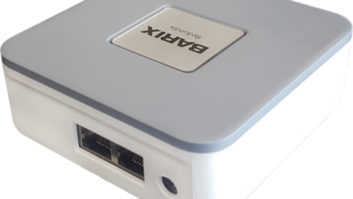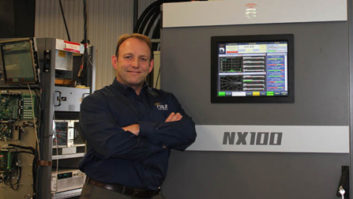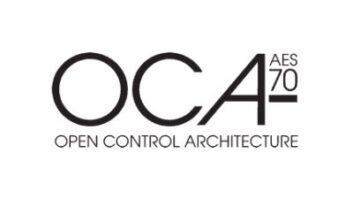Fig. 1 (above): IP microwave systems are bidirectional, half or full duplex, and make it possible to continue IP audio from the IP console, through the IP audio network and to the transmitter site.
�
Dee McVicker is a spokesperson for Wheatstone.��
�
Nothing can turn energy into inertia quicker than having to set up an STL or move programming from one site to another. With available STL frequencies an endangered species and program payloads now the size of Texas, one solution is a class of IP technology known as IP microwave links.
���
These RF links have been used by businesses and other industries for some time. More recently they have found their way into broadcast facilities as a practical way to transport linear audio within 25 or more miles, line-of-sight, from the studio audio network to the transmitter, stadium or other location.�
�
IP microwave links are ideal STLs because of their high-speed, bidirectional and license-free or �friendly characteristics. They�re also extremely affordable, which make them an excellent IP zipline from the AM studio/transmitter to those new FM translators, or as a substitute link in lieu of expensive Internet or mobile service to the transmitter site.
�
By putting up an IP microwave link from the studio to the transmitter or translator site, the site becomes part of the Ethernet network. �It�s almost like from an IP standpoint, that tower is sitting as part of your building,� said Jeff Holdenrid, who specializes in wireless IP for broadcast and other emerging markets for DoubleRadius engineering firm in North Carolina. Jeff has installed dozens of wireless IP microwave systems with audio networks such WheatNet-IP in the past five years, most averaging in the 20 to 25 mile range, although a 50-mile range is possible.
�
Little more than an IP radio and antenna is needed on each end. Linear audio from the IP audio network feeds directly into the IP radio through RJ-45 connectors. And because it�s an IP link, that means it can carry bidirectional audio, camera video, voice-over-IP, and data of all kinds. Both ways.
�
For example, a Wheatnet-IP IP88D BLADE (the I/O units used to connect the network together) could easily run 8 stereo channels each way through an IP radio link, and depending on the bandwidth of the link, there might also be room to move other data such as surveillance video, VoIP, or remote control.
�
IP radio and antenna systems start at a few hundred dollars and are available for the unlicensed 5.8 GHz band as well as frequencies in the Part 101 band (usually 6 GHz or 11 GHz), which opened up to broadcasters in 2011 when the FCC abolished the so-called last link rule.
�
�
To License or Not to License?
Licensed-frequency IP wireless systems have the obvious benefit of a licensed frequency as protection against someone using and interfering with that frequency, and are therefore popular as a main STL where 950 MHz frequencies are hard to get.
Applying for a Part 101 licensed frequency is fairly straightforward. Just as they do for a 950 MHz application, wireless network engineering companies such as DoubleRadius send out a PCN � prior coordination notice — in order to find channels available for use. According to Holdenrid, broadcasters can often begin using a licensed frequency for a wireless IP STL within a few weeks, providing they�re not located within 10 miles of a U.S. border.�
Unlicensed-frequency IP wireless systems do not require a licensing process, and because they�re the more affordable of the two, are typically used as a backup STL. �They�re also priced affordably enough to bring VoIP communications to transmitter sites. �A lot of broadcasters are paying $600 or $1000 a month for their Internet connection to [a very remote] transmitter site. Other than a tower climb to install the wireless, their return on investment [for an IP link] is two to three months compared to paying for a leased line from their provider,� explains Holdenrid.
Pricing starts at $500 for a basic unlicensed-frequency wireless IP system complete with radio and antenna and goes up to $30,000 for a licensed-frequency system, depending on how far, how fast, and how reliable that link needs to be. Licensed systems are generally full duplex, whereas unlicensed wireless IP systems are almost always half-duplex.
�
Handling Latency on Unlicensed Systems
One critical difference between unlicensed and licensed wireless IP systems is how the two handle latency. According to Holdenrid, IP wireless radios operating on licensed frequencies have exclusive use of the band and therefore have a consistent, lower latency, typically around 100 microseconds. Comparatively, latency on an unlicensed system can jump from 2 milliseconds up to 12 or 20 milliseconds depending on interference or even changes in weather patterns.
For this reason, Wheatstone has designed and introduced a special network unit, the Network EDGE, which provides the data buffering needed between the studio IP audio network and the STL in order to handle the latency swings typical of unlicensed IP radios. The EDGE provides the necessary delay as a buffer to any latency shifts that come across the link and acts as an interface between the WheatNet-IP audio network and the IP radio.
��Unlicensed IP has taken off because for 1,000 dollars you can get a system, and now that the EDGE can hold the clock time consistently, we�ll probably see more applications for these,� comments Holdenrid.
�
Differences in Distance and Throughput
On a licensed-frequency system, throughput is consistent. A 100 Mbps IP wireless link on a licensed frequency will operate at 100 Mbps whether its range is six miles or 20 miles.�One of the reasons licensed-frequency IP radios are able to maintain throughput is because of adaptive modulation, an ability to adjust capacity to meet throughput requirements.
For unlicensed frequency systems, broadcasters can expect to trade off throughput for distance. �The biggest unlicensed radios — like the Airfiber by Ubiquiti � have a shorter range and you can pull 700 megs out of them in a perfect world scenario (half-duplex),� explains Holdenrid. But with licensed systems, he adds, �We can stack up greater than 2.5 gig.�
If you�re considering an unlicensed system, features like interference mitigation will be important so if there�s interference on one frequency, the radio will automatically tune to an unused frequency for consistent service.� �In the 5.8 world, there�s the signal to interference ratio � how much noise it can take before the link drops. Some of these products have interference mitigation, where they see the frequencies all the time, so if someone puts something up on your band, it jumps to the best frequency it can perform on. If you�re considering unlicensed, that�s going to be a big product differentiator,� says Holdenrid.
�
Planning�
To determine how much throughput is needed for a licensed or unlicensed IP wireless link, the rule of thumb is to start with 100 Mbps per station and then add on current requirements such as VoIP capability or video surveillance data. Plan for 100 Kbps each direction, per line, for VoIP and between 512 Kbps and 2 Mbps for video, depending on resolution, frame rate, and color depth required. It�s prudent to plan for another 20 to 40 percent above that for weather conditions overhead and any new requirements bound to pop up in the next several years.
Some of the unlicensed IP radios and all of the licensed radios provide software upgrades that make it possible to scale up in throughput, starting at 250 Mbps and scaling up to as much as 1 gigabit.
�
Fig. 2 (left): Manufacturers such as Ubiquiti Networks and Cambium Networks have been making IP radios and antennas for some time. Shown at left is a Cambium system.

To find out more about IP microwave links, be sure to attend the session �Extending IP Audio to the Transmitter Using Part 101 or Unlicensed IP Radios� during the NAB Show, April 19, between 10:30 and 11 am. �











